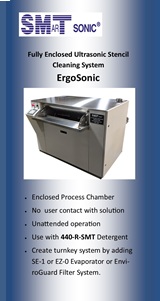|

|
|
| Ask the Experts | |||||||
|
|||||||
|
April 16, 2007 - Updated July 4, 2007 - Originally Posted Using non-RoHS components in RoHS processWhat are the factors we must be aware of when we using non-ROHS components in a ROHS process and vice versa. Viswanathan |
|||||||
| Expert Panel Responses | |||||||
|
Because of the number of products (military, medical, etc.) that are exempt from RoHS, mixed metal manufacturing is becoming very commonplace. Component suppliers and PCB manufacturers have transitioned to lead-free finished devices and boards and finding SnPb finished parts is becoming more difficult. Therefore, assemblers are forced to use Pb-free finished components or PCBs in an otherwise SnPb process. With standard leaded devices, the most common issue with mixed metal manufacturing is improper wetting. But much more catastrophic problems exist when using lead-free bumped array devices within a SnPb process. SnPb solder pastes achieve liquidus at 183°C but the Pb-free SAC alloys used to bump array devices most often require a temperature of 217°C. If the lead-free BGA and CSP bumps are processed at lower, tin-lead temperatures, incomplete bump melting or collapsing occurs. Ideally, the goal is to promote even distribution of lead (Pb) from the tin-lead paste throughout the solder joint but, if the lead-free bump doesn't melt completely, achieving this condition is impossible. Without the lead evenly dispersed within each solder joint, premature joint cracking and early thermal fatigue are the most likely outcomes, yielding uncertain device reliability. The best solution for this problem is to work within an assembler's current process and enable the use of a single paste for the entire assembly. The temperature has to be raised enough so that the tin-lead/lead-free mixture dissolves the lead into the solder joint and results in a homogeneous mixture and a higher reliability end-product. Through a unique formulation, Henkel has developed a tin-lead paste that solves the mixed metals dilemma for today's manufacturers. Multicore® MP218 is a halide-free, no-clean solder paste developed specifically for compatibility in higher-temperature processes. Comprised of similar raw materials, activators and components used in the company's lead-free solder pastes, Multicore MP218 effectively achieves lead-free performance within a tin-lead system. The extra activity and wider process window of the material overcomes challenges caused by the interaction of SnPb solder and lead-free device finishes. Multicore MP218 also has a high resistance to humidity -- another condition that is problematic and exacerbated in a SnPb – Pb-free mixed environment. The properties of Multicore MP218 alleviate many of the humidity-related challenges of pre-mature drying or undue moisture absorption and are suitable for varied global climactic conditions.
Marketing 360-Biz Douglass Dixon is the Chief Marketing Officer for 360 BC Group, a marketing agency with offices throughout the US. 360 BC specializes in consulting and implementing successful marketing programs that utilize the latest in marketing, sales and technology strategies. As an electronics veteran, Dixon has worked in the industry for over 30 years for companies like Henkel, Universal Instruments, Camelot Systems, and Raytheon. Dixon's electronics industry experience includes a broad skill set that includes engineering, field service, applications, product management and marketing communications expertise.
Here are some generic considerations to keep in mind when combining components: PCB: 1. Is the PCB capable of withstanding the processing temperature? (High performance FR4) 2. Does it require any special handling and storage (moisture sensitivity)? 3. PCB pad Surface Finish (High Temp OSP, ImAg, ENIG or ImSn) 4. PCB thickness and the need for specialized fixturing to prevent bowing/warping of thin PCBs 5. PCB properties (Tg, Decomposition Temperature) 6. Proper Identification to track inventory Components: 1. Storage and Handling (Humidity Free Environment) 2. Lead or Termination finish and material of solder ball if using area array packages 3. Identification and inventory management 4. Component Maximum temperature 5. Moisture Sensitivity Level and rating (Higher MSL level for RoHS components) Process: 1. Paste composition (alloy) – Higher temperature melting 2. SMT Stencil aperture requirements (1:1 or reduced) 3. Flux content and characteristics (Wettability) 4. Viscosity and Tack behavior under various ambient conditions 5. Oven profile and thermal requirements (>220 deg C and longer TAL for Sn/Pb paste with Lead-free Solder balls) 6. Board support in the middle of the conveyor for lead-free reflow soldering 7. Wave solder bath to be changed for RoHS process 8. Rework system and high temperature rework needs 9. Lead-free solder wire for rework
President inspīre solutions LLC Bjorn Dahle is the President of inspīre solutions LLC. He has 20 years experience in the electronic manufacturing industry with various manufacturing equipment companies covering pick & place, screen printers and thermal process management.
|
|||||||
| Submit A Comment | |||||||
|
Comments are reviewed prior to posting. You must include your full name to have your comments posted. We will not post your email address. |
|
Free Newsletter Subscription
Circuitnet is built for professionals who bear the responsibility of looking ahead, imagining the future, and preparing for it. Insert Your Email Address |
|

|




